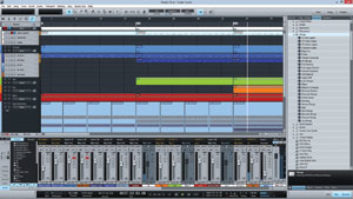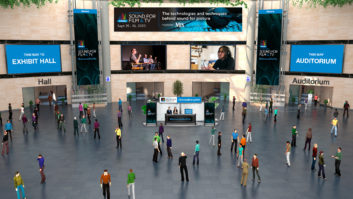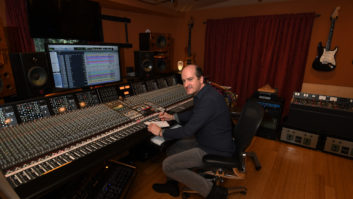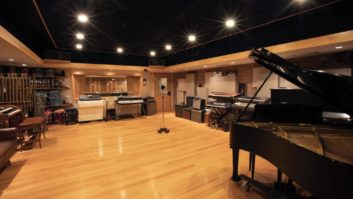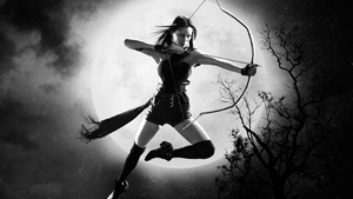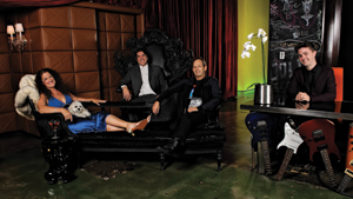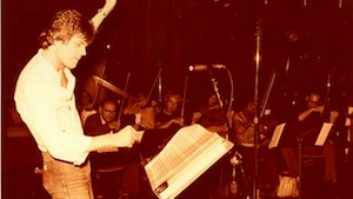
We asked three gearheads to select the equipment for a recording room. Each was given a different virtual budget — $20,000, $60,000 or $175,000 — for his favorite goodies. Despite spending imaginary cash, a lot of thought and creative wrangling went into the process, and with appropriate substitutions, additions and/or deletions, the studios presented here should provide useful insights into equipping your facility, whatever the budget. It should be noted that the emphasis here is strictly on gear rather than acoustic treatments, room construction, etc. As in all endeavors, your mileage may vary. Happy shopping!
SERIOUS ENTRY LEVEL
The $20k Project Studio
By Robert Hanson
My imaginary setup is an “entry-level” $20k project studio that can handle composing, sound design, voice-over and mixing in stereo. The system leans heavily on software instruments and processing, while incorporating several different DAWs for working across multiple formats. (All prices will be the actual retail or approximations thereof unless noted.)
I’ll start at the Apple store. The main computer is a dual 3GHz quad-core Mac Pro for $3,599 and a refurbished 23-inch Apple Cinema HD display for $749. To save a few bucks, I’ll skip any extra factory RAM, hard drives or extras, mousing over to www.otherworldcomputing.com to score 16 GB of RAM (using 4GB modules) for $919 and two 1TB Seagate Barracuda 7200.11 SATA II hard drives at $151 each, which augment the Mac Pro’s standard 320GB drive. With this configuration, four open RAM slots and one open hard drive bay remain, should you need to upgrade down the road.
The goal of this studio is to be able to work across several different DAWs based on project/client needs. Converters have a profound effect on the quality of your creations, so this is no place to skimp. My main audio interface is an Apogee Ensemble ($1,949), supplemented by a $1,200 Digidesign Digi 003 Rack. In terms of DAWs, the Apogee is tailor-made to work with Logic Studio ($499) — an obvious choice for composing. For working with loops, alternate arrangements and sound design, Ableton Live 7 ($499) is another go-to product. On the Pro Tools front, the 003 includes the latest version of Pro Tools LE, but to up the track count to 48 and get some of the pro features (Multi-Track Beat Detective, SoundReplacer, etc.), I added the $495 Music Production Toolkit option.
Now there’s approximately $10k left for monitors, outboard, mics, controllers and additional software. For monitoring, a cost-effective option that delivers professional accuracy is Blue Sky’s ProDesk 2.1 for $1,258. This system uses two audio interfaces, and switching cables behind a desk is a nightmare, so Mackie’s $299 Big Knob lets me switch between audio interfaces while providing talkback capabilities and allowing for another set of monitors in the future. Outboard needs here are fairly minimal. Both audio interfaces have decent onboard preamps, but for critical recording, a dedicated, boutique-quality channel strip is a must. My pick for this application is Universal Audio’s LA610 Mk II ($1,599), offering a preamp, EQ and optical compressor in a 2U chassis. For miking vocals, single acoustic instruments (guitar, winds, etc.) and possibly the occasional guitar cab, these three microphones should cover things nicely: BLUE Blueberry ($999), RØDE NT4 stereo condenser ($529) and a pair of Shure SM58s ($160 each).
Composing and sound design are at the forefront of this setup, and M-Audio’s Keystation Pro ($499) master MIDI keyboard features a hammer-action keyboard, 59 assignable controls (faders, knobs, etc.) and 10 rewritable presets. Now some cool software instruments and effects will take this system over the top. For instruments, samplers and guitar amp emulation, the Native Instruments Komplete 5 bundle for $1,149 includes all 11 major NI products including Reaktor 5, Guitar Rig 3, Kontakt 3, Akoustic Piano and the like. Most composers would be hard-pressed to run out of fodder with this package. For mixing chores and to access some classic hardware emulations, Universal Audio’s $699 UAD-2 Nevana 32 package offers more than twice the DSP power of the older UAD, and it includes 32 channels of Neve 88RS and a host of other UA plug-ins. And finally for restoration chores, I’ll spend a little extra on the Waves Restoration Bundle ($1,800) — as any user will attest, this bundle includes some of the finest noise, hiss and pop-removal tools available.
The total comes in just under the $20k mark, so with tax, cables and other unmentionables I’m slightly over budget. However, I’ve included a few luxury items — especially on the software front — that could be omitted without seriously affecting the functionality of this imaginary project studio.
LEAN, MEAN PC MACHINE
The $60k Package
By George Petersen
As my cohorts spec’d Mac systems, I’m going for the pure power and speed of a PC. The emphasis is a hybrid of traditional and virtual production, while keeping my eyes — and ears — on performance and serious fidelity. And with $60k in (virtual) cash to spend, I’m going first class.
At the heart of the studio is a PCAudioLabs Standard Black (no frills) enclosure. Don’t let its drab exterior fool you. Under the hood of this $2,585 beast is an Intel Core2 quad 3GHz Q9650 CPU, with 4GB RAM, 320GB system drive, two 1TB data drives, dual DVI ATI Radeon HD3470 graphics, Pioneer 20x DVD burner, Silent Treatment sound deadening, FireWire 800 card and the ever-stable, dependable Win XP Pro. Options include Vista, AMS chipsets, rackmount case and many more. Display-wise, I have two 22-inch Viewsonic VX2240W LCDs with DVI interfacing — each at $409 list.
On the DAW software side, I choose Cakewalk SONAR 8 Producer’s Edition ($619), but everybody has their faves, whether it’s Steinberg Cubase, Nuendo, Magix Sequoia or SAW Studio.
The all-important interface here is RME’s FireFace 800 ($1,999), routing to 28 outputs simultaneously with 24/192 clarity. It also boasts a great sound, solid drivers and four respectable onboard preamps. Upping the ante is Focusrite’s ISA828 ($2,999) with eight mic/line inputs (four with DI jacks) and optional ADC card. For the money channel, I splurged on a $4,000 Manley VoxBox — one channel of tube mic pre, compression and EQ, but it makes any input (mic or DI) sound like heaven. Another flavor is Groove Tubes’ The Brick — mostly as a tube direct box, but it’s equally useful as a mic preamp and line driver — and it’s a deal at $499.
The centerpiece is Solid State Logic’s new Matrix line mixer/router/DAW controller ($25,995) set into Argosy Console’s Mirage Matrix housing ($5,645), which makes the package look a half-million, while keeping everything tidy and adding 12 rackspaces (six per side) for outboard goodies. Those with more can add Argosy’s matching 11-space sidecar(s), but with all of my plug-ins, I won’t need it.
I also bought the $3,365/pair JBL 6328P-Pak powered room-correction monitor system (no sub, but it’s optional) on two Argosy 42-inch X-stands ($259/pair) with a couple Primacoustic RX9-DF down-firing Recoil Stabilizers ($150 each) set at a 5-degree downward slope to optimize the listening area. Speaking of listening, I added the Aphex HeadPod 454 headphone amp ($249) with four channels of loud, distortion-free — and minimal fatigue — playback and three beyerdynamic DT770 closed-back studio phones at $299 each.
Even though SONAR, Cubase, et al, ship with powerful DSP suites of their own, he who dies with the most toys wins, so I added Waves’ new $900 Silver Collection. The latter’s 16 plugs include the Renaissance Compressor, Renaissance Equalizer, Renaissance Axx, IR-L Convolution Reverb, L1 Ultramaximizer, C1 Parametric Compander, S1 Stereo Imager, Q10 Paragraphic Equalizer, MaxxBass, MondoMod, Enigma, TrueVerb, SuperTap, Doubler, DeEsser and Paz Analyzer — a deal at $50-plus-change apiece. One gotta-have plug is SPL’s sweet new Analog Code Transient Designer — shipping now in RTAS/VST/Audio Units for $299. A more unusual plug-in selection is the Peterson Strobosoft 2 guitar-tuning software — a bargain studio essential at $49.
I really went wild with mics, selecting 14 classic and future-classic models. In the sweet-vocals-but-great-on-anything department, the selections are Neumann TLM 49 ($1,998), the RØDE K2 tube ($999), BLUE Baby Bottle ($799) and the Cascade Fat Head II Stereo Pack — two ribbon mics, stereo bar and Blumlein mount in a nice case for a bargain $400. For applications where versatility is a must, the selections are Audio-Technica’s small-diaphragm AT4041/SP stereo pair ($795) and four gotta-have-’em Shure SM57s ($140 each). More specialized is the $179 Audix I-5 (perhaps the new standard on snare), Sennheiser’s $154 E-609 (remake of the MD-409, a guitar amp classic) and the Electro-Voice N/D 868 kick drum mic ($388).
There are still a few loose ends. At $310, Furman’s P8 Pro 20-amp power conditioner offers protection and peace of mind. I also budgeted $2,000 for some miscellaneous purchases, such as mic stands and cabling — both XLRs for mic/lines (from various suppliers) and Planet Waves’ new DB-25 breakout snakes, which are ideal for SSL Matrix interfacing.
It’s a tidy $60,000, although with all prices MSRP, you can probably come in a good deal lower and pick up that Les Paul Custom you’ve always wanted.
HIGH-END APPROACH
The $175k Room
By Kevin Becka
The biggest-budget studio is a tracking/over-dub room that can cater to both the old and new school. It’s DAW-based but has some incredible analog hardware. The $175k budget presupposes items such as interconnects, patchbay, mic stands, furniture and accessories. I shopped around for the best price on all gear, so strike the word “retail” from your vocabulary.
Recording will be to a Digidesign Pro Tools HD3 system ($13,000) through 24 channels of Lynx Aurora converters ($4,990) addressing Pro Tools through Lynx’s LT-HD cards ($700). The system will be clocked by the rock-solid Grimm CC1, offering 16 word clock outs and 90 dB of jitter suppression at 10 kHz ($1,750). This DAW will run on an Apple Mac Pro with four 3.2GHz quad-core Intel Xeon processors, 8GB RAM, two 500GB 7,200 rpm Serial ATA 3Gb/s hard drives and two 23-inch Cinema HD displays ($7,947). AC power will be handled using the Balanced Power Technologies BP-10.5 Signature Plus ($2,999). There are lots of extra slots with Digidesign’s 6-card PCIe expansion chassis ($2,395), giving me five open slots for expansion. I’ll use one of those slots for SSL’s Duende PCIe system ($1,295) offering 64 channels of processing on Duende’s dedicated DSP and plug-ins.
The centerpiece of this studio will be the Tree Audio Console ($38,750), which, due to its modular nature, assures a variety of sonic colors. The 24-channel desk has three tiers available to accept 500 Series modules. I’ll start building the desk by choosing some vintage flavor with four API 512C preamps ($760). Next, I chose four Shadow Hills Mono GAMA mic preamps ($795) with switchable output transformers and added four Chandler Germanium 500 preamps with their tone-bending feedback control ($950). I plan on putting some sweat equity into the room by building four Eisen Audio D.I.Y. 500 Series preamps, which lets me choose from a wide variety of op amps, I/O transformers; this is an inexpensive, custom way to add more variety to the front end (about $400 each, depending on parts). Finishing out the first tier, four Atlas Pro Audio Juggernaut ($895) preamps with switchable input impedance promise even more tonal options and four OSA MP1-L3 Big Daddy ($650) pre’s with Lundahl transformers.
EQs on the second tier of my console include four Speck ASC-V ($735) 4-band EQs. I’ll put in more solder time and save more dollars by building four kit-based EQSM1 EQs from S and M Audio ($350). Next are four Purple Audio Odd Inductor EQs ($735), four API 550B EQs ($1,195) and eight pricey-but-sweet A Designs EM-PEQ ($1,235), promising a tip-o-the-hat to the classic Pultec EQP-1A.
Rounding out my 500 Series module purchases, I bought a variety of dynamics controllers including four of the versatile Burgin/McDaniel Komits ($750), four Purple Audio Action FET compressors ($675), four API 525 discrete compressors ($1,195), four AnaMod AM660 ($1,295) compressors modeled after the coveted Fairchild 660 and four Empirical Labs DerrEssers ($649) for taming stray sibilance. For mixing purposes, I added another two AM660s across the stereo bus in the Tree Console.
For effects while recording, Lexicon’s PCM 96 hardware effects box ($2,999) works as a stand-alone unit or within Pro Tools via the included software. For more clean ambience is the Bricasti M7 high-resolution digital reverb ($3,695).
Mic choices include two R92 ribbon mics from AEA ($1620), two Royer 121s ($2,590), four PR30 dynamic moving coil mics from Heil ($996), a Yamaha SubKick ($369) and four SM57s from Shure ($400). For use on drum overheads, piano, strings, guitars and vocals, I’ll have two Sennheiser MKH-800s ($5,400), a Korby Audio KAT Red ($3,495), the DPA 3521 compact stereo kit ($3,500), two SE Electronics SE-4s ($698), two new AKG C214s ($1,198) and two Mojave MA-200 tube mics ($1,990).
This means nothing without great playback, so I’ve chosen KRK E8B speakers ($5,000) and M-Audio’s Studiophile DSM2 monitors ($1,498) as an alternate listening source. For direct recording, I’ll use the DI inputs on the console’s preamps in the control room or two Radial JDI DI boxes ($800) and a pair of A Designs REDDI Tube Dis ($1,430) for studio use.
All this comes to $174,884, excluding tax, license, undercoating and pin stripes on the muffler.
CORE COMPONENTS OF EACH STUDIO
$20,000
Apple Mac Pro 3GHz quad-core
Apple Logic Studio
Apogee Ensemble
Digidesign Digi 003 Rack
Pro Tools LE w/Music Production Toolkit
Blue Sky ProDesk 2.1 monitors
Mackie Big Knob
Universal Audio LA610 Mk II
M-Audio Keystation Pro
Native Instruments Komplete 5
Universal Audio UAD-2 Nevana 32
Waves Restoration Bundle
$60,000
PCAudioLabs w/Intel Core2 quad 3GHz
Cakewalk SONAR 8 Producer’s Edition
RME FireFace 800
Focusrite ISA828
Manley VoxBox
Groove Tubes The Brick
Solid State Logic Matrix
Argosy Mirage Matrix housing
JBL 6328P Monitors
Waves Silver Collection
SPL “Analog Code” Transient Designer
$175,000
Digidesign Pro Tools HD3
Lynx Aurora Converters w/LT-HD cards
Apple Mac Pro Intel 3.2GHz quad-core
Digidesign PCIe expansion chassis
SSL Duende PCIe system
Tree Audio Console
500-Format Modules (A Designs, Anamod, API, Atlas Pro Audio, Burgin/McDaniel, Chandler, Eisen, Empirical Labs, OSA, Purple Audio, S and M Audio, Shadow Hills, Speck)
Lexicon PCM96
Bricasti M7 reverb
KRK E8B monitors
